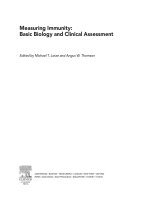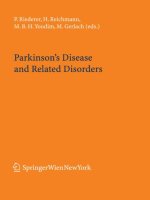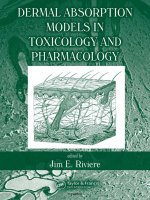EXPERIMENTAL AUTOIMMUNE ENCEPHALOMYELITIS – MODELS, DISEASE BIOLOGY AND EXPERIMENTAL THERAPY docx
Bạn đang xem bản rút gọn của tài liệu. Xem và tải ngay bản đầy đủ của tài liệu tại đây (7.65 MB, 172 trang )
EXPERIMENTAL
AUTOIMMUNE
ENCEPHALOMYELITIS –
MODELS, DISEASE BIOLOGY
AND EXPERIMENTAL
THERAPY
Edited by Robert Weissert
Experimental Autoimmune Encephalomyelitis –
Models, Disease Biology and Experimental Therapy
Edited by Robert Weissert
Published by InTech
Janeza Trdine 9, 51000 Rijeka, Croatia
Copyright © 2012 InTech
All chapters are Open Access distributed under the Creative Commons Attribution 3.0
license, which allows users to download, copy and build upon published articles even for
commercial purposes, as long as the author and publisher are properly credited, which
ensures maximum dissemination and a wider impact of our publications. After this work
has been published by InTech, authors have the right to republish it, in whole or part, in
any publication of which they are the author, and to make other personal use of the
work. Any republication, referencing or personal use of the work must explicitly identify
the original source.
As for readers, this license allows users to download, copy and build upon published
chapters even for commercial purposes, as long as the author and publisher are properly
credited, which ensures maximum dissemination and a wider impact of our publications.
Notice
Statements and opinions expressed in the chapters are these of the individual contributors
and not necessarily those of the editors or publisher. No responsibility is accepted for the
accuracy of information contained in the published chapters. The publisher assumes no
responsibility for any damage or injury to persons or property arising out of the use of any
materials, instructions, methods or ideas contained in the book.
Publishing Process Manager Oliver Kurelic
Technical Editor Teodora Smiljanic
Cover Designer InTech Design Team
First published February, 2012
Printed in Croatia
A free online edition of this book is available at www.intechopen.com
Additional hard copies can be obtained from
Experimental Autoimmune Encephalomyelitis –
Models, Disease Biology and Experimental Therapy, Edited by Robert Weissert
p. cm.
ISBN 978-953-51-0038-6
Contents
Preface VII
Part 1 Disease Biology 1
Chapter 1 Experimental Autoimmune Encephalomyelitis 3
Robert Weissert
Chapter 2 Studies on the CNS Histopathology of EAE and Its
Correlation with Clinical and Immunological Parameters 21
Stefanie Kuerten, Klaus Addicks and Paul V. Lehmann
Chapter 3 Assessment of Neuroinflammation
in Transferred EAE Via a Translocator Protein Ligand 47
F. Mattner, M. Staykova, P. Callaghan, P. Berghofer,
P. Ballantyne, M.C. Gregoire, S. Fordham, T. Pham,
G. Rahardjo, T. Jackson, D. Linares and A. Katsifis
Chapter 4 The Role of CCR7-Ligands in Developing Experimental
Autoimmune Encephalomyelitis 65
Taku Kuwabara, Yuriko Tanaka, Fumio Ishikawa,
Hideki Nakano and Terutaka Kakiuchi
Part 2 Experimental Therapeutic Approaches 81
Chapter 5 Therapeutic Effects of the Sphingosine 1-Phosphate
Receptor Modulator, Fingolimod (FTY720),
on Experimental Autoimmune Encephalomyelitis 83
Kenji Chiba, Hirotoshi Kataoka, Noriyasu Seki and Kunio Sugahara
Chapter 6 Effects of Anxiolytic Drugs
in Animal Models of Multiple Sclerosis 107
Silvia Novío, Manuel Freire-Garabal and María Jesús Núñez-Iglesia
Chapter 7 Immunomodulation of Potent
Antioxidant Agents: Preclinical Study
to Clinical Application in Multiple Sclerosis 139
Shyi-Jou Chen Hueng-Chuen Fan and Huey-Kang Sytwu
Preface
`Experimental Autoimmune Encephalomyelitis – Models, Disease Biology and
Experimental Therapy` is totally focused on the model of multiple sclerosis,
experimental autoimmune encephalomyelitis (EAE). The book chapters give a very
good and in depth overview about the currently existing and most used EAE models.
In addition, chapters dealing with novel experimental therapeutic approaches
demonstrate the usefulness of the EAE model for MS research. MS is a severe disease
of the central nervous system (CNS) that leads to progressive neurological deficit.
Inflammation in the CNS causes myelin destruction, axonal and neural loss. Even
though the disease has been known for centuries, there is only an incomplete
understanding of the disease biology, especially of the mechanisms that lead to axonal
and neural loss.
With the introduction of interferon-beta preparations in the treatment of MS about 20
years ago, a major therapeutic breakthrough has been achieved in a disease that was
considered to be non-treatable. Since then, a number of new treatments have been
introduced like Glatirameracetate, Natalizumab and Fingolimod. More are to come.
All of these mainly affect inflammatory processes in the CNS. These treatments are not
curing the disease but provide much benefit for the patient, reduce relapse rate and
severity and slow disease progression. In research and development, a lot of effort is
currently being done to discover treatments that are neuroprotective or restoring. Not
much light is on the horizon there. EAE is also a very important model that is used in
academic research as well as biotech and industry. As outlined in great detail in the
different book chapters, different EAE models provide insights into different aspects
of MS disease biology and pathology. There is not one model that adequately
addresses all facets of MS. For the researcher it is of paramount importance to select
the most adequate model for the specific research subject. The book can possibly be of
major help in this situation, since, unlike most journal reviews, the book chapters
provide a more personal insight into the selection of adequate models. This is an
international book with authors contributing from all over the world (Australia,
Germany, Japan, Spain, Taiwan, USA). There is an impressive international Faculty
that provides insight into current research themes. This further demonstrates the
importance of EAE in research all over the world. I am convinced that this book will
provide many established researchers and students with novel insights and guidance
VIII Preface
for their research and will help to push the field forward to better understand the
disease biology of MS and other autoimmune diseases and help to establish novel
therapeutic approaches.
October 2011
Robert Weissert
University of Regensburg,
Germany
Part 1
Disease Biology









